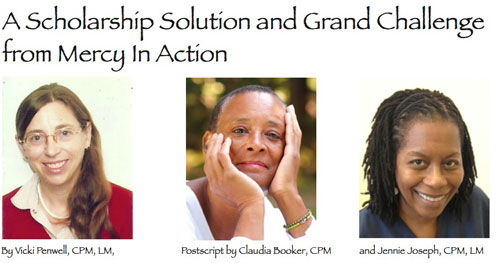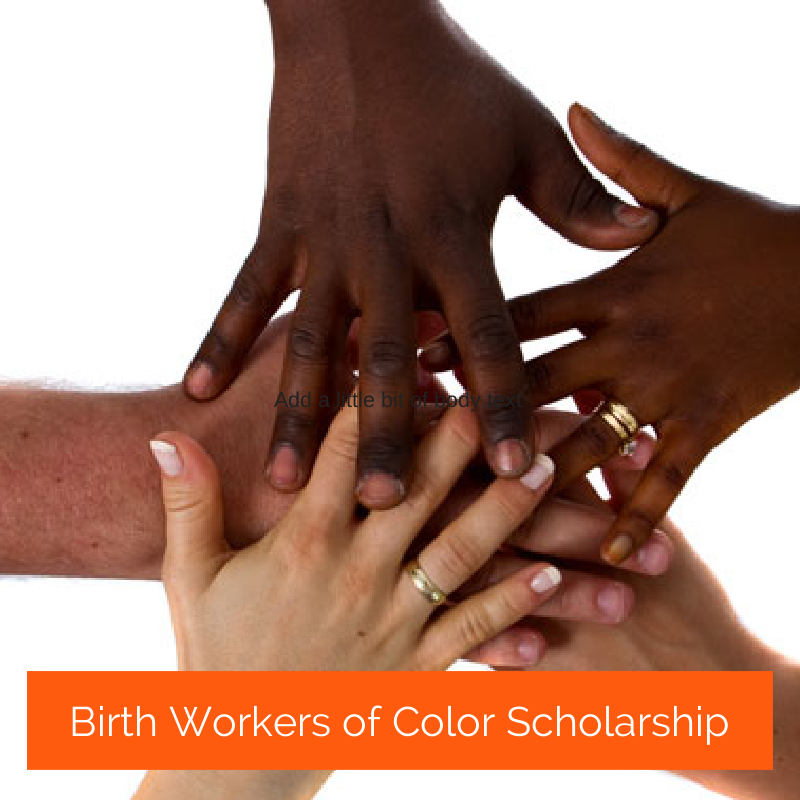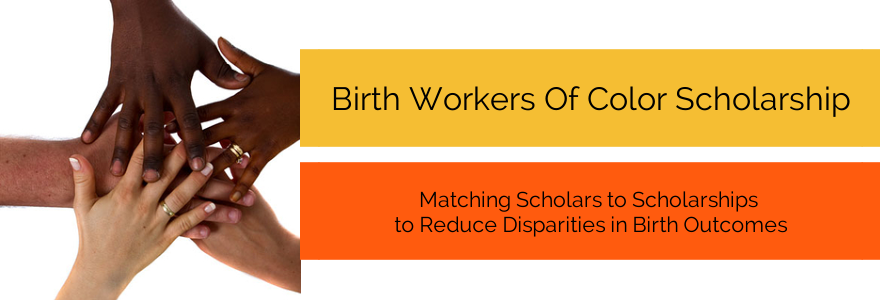
A midwife for every woman. That is our grand ideal. But what if you are a woman of color in America, where is your midwife from your unique culture?
The Problem
Being aware of the grave injustice of black babies dying at twice or three times the rate of white babies in America, and knowing that the disparity in maternal mortality between black women and white women is even wider in the USA, this question takes on dire urgency. If we believe that midwifery care produces superior outcomes, and if we believe that midwifery care could be a part of the solution in reducing prematurity and other causes of newborn death, and if we believe that midwifery care can keep mothers from harm, then it becomes life and death that we have more midwives of color serving the population of women of color in America.
A Solution
In July 2012 Mercy In Action School of Midwifery, the school I founded and direct, made public a simple scholarship program for midwife students of color in the USA to address this issue.
We modeled this new scholarship program after our decades - long scholarship program in the developing world, where we train national midwives from “third-world” economies at no charge, supporting the program with the tuition charged to students from “first-world” economies who come to study under us. In fact, for my entire 33 year career as a midwife and educator I had always offered unpublished scholarships for low income women from America, but it was never formal nor advertised, and it was not specific to the issue of creating more midwives to serve the populations that have the worse outcomes in birth in the USA. We have now corrected that in a deliberate way.
The idea to provide scholarships to women of color in America came from discussions with my friends and colleagues who are themselves women of color in the USA. (Black, Asian, and Hispanic) They shared with me that due to economics, fewer women of color had access to CPM out-of-hospital based training programs within America. This is why we see more CNMs of color than CPMs of color, because the access to scholarship and funding programs is greater for a mainstream RN to CNM route to midwifery. However, if we are to right a centuries old wrong, it is going to take more than a handful of black and brown midwives. The population of midwives must reflect the population of birthing women within this diverse nation.
Since we launched our scholarship program on our website in July 2012, Mercy In Action has been inundated with requests for scholarships to our Distance Academic and other midwife training programs we run. Intending to only give out one full scholarship per year to each of our offerings, we have now awarded 11 full scholarships so far in the past five months to women of color, seven of them to our Distance Academic School and four to seminars we teach. We felt too terrible to turn anyone down who applied, given that the applications we received were so full of hope and love and commitment to help end the deadly disparity issues in birth outcomes!
Thanks to the generosity of our CPM staff who has committed to take on extra work (and tighten our budget belt) as we launch this year, we were able to accept all the applications in 2012; however, it is unsustainable for us as a small non- profit to be able to continue to give more than one full scholarship to every course we offer per year in the future.
Then I received an email letter from Claudia Booker; she had just found out about our scholarship offerings and she wrote to thank me, saying, “How can we get others to follow your lead?” Answering that question is what led us to write this article together.
The response we received has shown that there is a real need; that there are many young aspiring midwives in the wing just waiting for an opportunity. Perhaps the solution to our current shortage of midwives to serve African American and American Indian/Alaska Natives (the groups with the worst disparities in birth outcomes: see chart below) populations in the USA could actually be remedied if we only have the will to make small adjustments in our existing midwifery school programs to allow those who cannot now afford the training a chance to study and apprentice.
The Grand Challenge
And so, our Grand Challenge is this: What if every midwifery program in America, big or small, non-profit or for-profit, were to offer one FULL scholarship per year to a qualified candidate who was a woman of color?
If every school or program now in existence were to offer one full scholarship per year, the burden will not be too much on any one school’s budget. We will all share the responsibility and privilege of addressing a grave injustice in our own time and country. Within a few years we could see this imbalance shift and begin to see many women of color serving their own populations with quality midwifery model care.
Based on the statistics that Jennie Joseph is getting with her open access program in Florida, we know that more midwifery care for women of color would lower the current death rates of babies and mothers in the USA.
How long would all midwife schools training CPMs in America commit to run this scholarship program? Only until black and white babies and mothers are surviving at the same rate in this land of the free that we call home.
Personally, I don’t want to live in a world where mothers and babies with dark skin die at a much higher rate than mothers and babies with pale skin. It is not right, and it is happening right here in America. We can change our sphere of influence, lets do it! Let it not be said of us, the midwives and educators in America, that we missed our opportunity to improve birth outcomes in our own country of origin, even as more attention is being given to the global crisis in maternity care.
If you are the owner or director of a school, distance program, or any program that is training midwives on any level, write to tell us if you will join our Grand Challenge. If you are reading this article, write or call someone who does own or direct a midwife school to ask them to set up one full scholarship per year, in response to this challenge.
Claudia Booker has agreed to keep a database of schools that offer scholarships to women of color, starting now.
Together we can be the change we want to see in our world. Please join the challenge today; the mothers and babies cannot wait...
~Vicki Penwell is the founder and Director of Mercy In Action, a charitable faith-based non profit organization providing free maternity care and training midwives in the Philippines, as well as offering Academic programs of study in the USA. She has a masters degree in Midwifery and a masters degree in Inter-Cultural Studies. Vicki and Scott, her husband of 35 years, have an inter-racial family and 22 years experience living cross-culturally in Asia. See website: www.mercyinaction. org
___________________________________________________
Postscript by Claudia Booker, CPM, and Jennie Joseph, CPM, LM.
When I received an email about the Mercy In Action FULL scholarship program. I immediately wrote Vicki an email entitled, “My heart is singing”. Those are no small words for me.
It was as if pieces of various midwives’ and future midwives’ dreams and the wishes of their respective hearts were being shared across this planet and were finding ways to make these dreams come true. Women of colors in places too numerous to list had been praying “For a Way to be Made Clear”; midwives of conscience and an undying commitment to saving mothers and babies were scratching their heads and counting their pennies, and asking “For a Way to be Made Clear”. Incantations and prayers became conversations; became coalition conversations. Midwives of Colors and Vicki Penwell and Mercy In Action in the Philippines; Ibu Robin Lim and Bumi Sehat in Bali taking the lead by agreeing to provide one full scholarship a year for a qualified student midwife of color(s).
The question remains, “How do we get the commitment evidenced by these two midwives to be the commitment of all midwifery programs, overseas sites, and schools?
Many midwives have contacted me and asked, “... but what can I do?”
Certainly there is an understanding of the issue of perinatal disparities, the sheer numbers speak for themselves, but when it comes to tangible and meaningful actions to right this wrong, this is when the problem becomes seemingly overwhelming.
Midwives have long stated their position as being the optimum providers for low-risk pregnancies and that their work impacts and improves birth outcomes for American women in a positive way. And where women have the education, support and financial means they are availing themselves of this choice in larger numbers every year. But where they don’t, just stating that midwifery care is the answer without supporting practical means to access such care is disingenuous at best. If midwives truly wish to address these issues then concerted efforts need to be focused around reaching more women of all races and ethnicities and ensuring access to our evidenced-base mod- els of care. The best way to do that is to diversify midwifery through training, encouraging and sup- porting students and midwives of colors who are willing to serve all communities throughout the United States.
Ms. Penwell’s Grand Challenge, her call-to-action, allows us to be able to answer her by following these practical, doable steps – all of which can be taken immediately.
So, what can you do?
1. Raise Awareness:
• Acknowledge the problem is real and that it exists.
• Know the perinatal outcomes for your county, state or region.
• Raise awareness throughout your networks, become an authority on the disparities in your area.
2. Support Your Midwifery School or Program
(Including Overseas Clinical Sites)
• Find out if your alma mater or your current midwifery school has a scholarship program for a midwife (midwives) of color(s) – and let them know why you support them.
-
Find out why not, if that is the case, and be prepared to support that changing.
-
Find out what it would take for it to happen, if necessary – who would you have to speak to, is a meeting in order, who and where are your supporters for this change, what would it cost etc.
-
Create a scholarship fund from scratch or partner with existing funders. The scholarship recipients will need financial assistance with books, equipment, additional fees, computer software, in order to be able to fully participate; if the scholarship is to an overseas site funds will need to be raised for travel expenses. Contact your local midwifery organization and get your organization to financially underwrite these additional costs the scholarship does not cover.
-
Raise additional funds to ensure that your midwifery school or program has a robust library
of books, tapes, movies, and other resources that address issues of diversity, birthing issue of peoples of colors. -
Lead the speaker’s committee for your school to find (and pay the expenses of) speakers of colors to speak on various topics pertaining to the entire global world of midwifery, not just during February but throughout the year.
Vicki providing hand-on training to a midwifery student of color.
•
Lead your school or program’s Serve Committee to hire lecturers, teachers, assistant profes- sors, advisors, counselors, and staff of colors. Their input and sheer presence can substantially improve the quality of your program. In addition, the student(s) of color(s) will have an anchor, a friendly face, a comrade, an oasis/ refuge/back home with them. Do not invite students of colors and not provide them with the financial, social, emotion support to flourish and complete your program and become midwives! In other words, accept this challenge with the zeal and wholehearted commitment to succeed!
3. Be a Support
• Be a donor
• Be a preceptor
• Be a mentor
• Be a placeholder
It’s not that complicated, but it is a matter of life and death.
~Claudia Booker, CPM is a home birth midwife and activist in the Washington DC metro area. See website: www.birthinghandsdc.com
~Jennie Joseph, CPM, LM, is Director of the Commonsense Midwifery School and The Birth Place Birth Center in Winter Garden, Florida, and innovator of the JJ Way. See website: www.jenniejoseph.com

